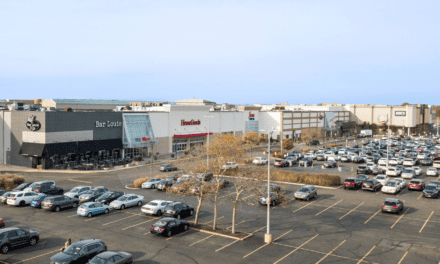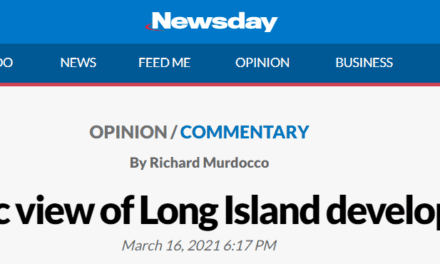The following was originally published on the Long Island Press on February 9, 2016. You can read the original here.
Long Islanders may have to wait just a little longer if they were expecting transformative growth at the Ronkonkoma Hub.
The reason for the delay? Sewering—and the disingenuous attempts of regional planning being undertaken by Suffolk County.
The Ronkonkoma Hub, the darling project for many-a-smart growth advocates, may be one of the few projects on Long Island worth the praise it has received. It offers the opportunity for true intermodal access spanning the automobile, bus, train and airplane. Unlike other ambitious projects its size, this $538 million Hub has faced minimal NIMBY outcry from the surrounding area. While residents’ concerns about density still haunt the project, overall public support for the Hub has been snowballing from both civic leaders and municipalities since it was first pitched a few years ago.
In 2012, East Setauket-based Tritec development became the master developer for 50 or so acres around the ever-bustling Ronkonkoma train station. One of the region’s busiest commuter transit hubs, the site has long been viewed as an economic engine to power Suffolk County. Only recently has any real progress on this goal been seen. In 2014, the Brookhaven Town Planning Board adopted what’s called a form-based code to set an orderly template of growth. Last year the town board gave the green light to the first phase of development at the Hub, with 489 residential units slated for 10 acres. Progress, yes, but the approval came with the condition that the project would have a viable sewer connection.
Last October, a supposed regional planning alliance was formed between Brookhaven and Islip, the two towns where the Hub is located. At first glance, one would assume this partnership would have helped the project further along, but this hasn’t been the case.
Once again, the issue of sewers and the treatment of wastewater, which has plagued many Long Island projects, reared its ugly head.
The Town of Brookhaven had authored and adopted an Environmental Impact Statement that included a proposal for a $25 million sewer plant for the Hub project. Suffolk County accepted the concept, and the legislature approved the funding to make it a reality.
Since then, the county has apparently shifted its position. Now it claims it wants to build a seven-mile pipeline from the Ronkonkoma Hub site through the Village of Islandia (whose residents reportedly weren’t exactly pleased with the idea) to the Bergen Point Sewage Treatment Plant in West Babylon. From there, wastewater would be released three miles into the Atlantic Ocean via an aging outfall pipe. The county claims that its solution would save Suffolk’s already beleaguered taxpayers $2 to $3 million while shaving precious time off the ever-expanding construction timeline, now slated to take another decade.
Both Islip and Brookhaven were initially onboard, but state Sen. Tom Croci (R-Islip), a former Islip Town supervisor, proposed another pipeline path. His new route would essentially double the opportunity for growth within the township by offering more sewer infrastructure, but it would also more than double the cost from $24 million to $55 million.
“This alternate route would be much more expensive,” admitted Islip Town Councilwoman Trish Bergin-Weichbrodt, a Republican, at the March 2015 press conference held at Islip Town Hall to promote the new trajectory, “but the benefit would certainly be worth the buck.”
In Croci’s proposal, the extended sewer line would meander south through Oakdale and Sayville before hooking up with a connection to Bergen Point. While the idea sounds nice, no public officials involved with proposing the longer route provided details regarding how this expanded pipeline would be funded.
What is most vexing is why at this stage of the game is the answer to the wastewater issue not already understood, agreed upon and moving forward?
The county’s sewer solution seems to accommodate Tritec’s needs and little else. Not only does its proposed pipeline shortsightedly bypass MacArthur Airport, it skips any additional opportunities for regional growth beyond the Ronkonkoma Hub. Sen. Croci’s route extension addresses these issues, but doubles the price point far beyond the original proposal as well as the county’s cheaper route.
From the regional perspective, Suffolk County, Islip and Brookhaven should decide together which of these three options is the most beneficial: a completely new wastewater treatment plant constructed at the Hub site to discharge clean water back into the aquifer, which might also spur growth at nearby MacArthur Airport and its surrounding industrial areas; a quick-fix pipeline proposed by Suffolk County that bypasses the airport; or Sen. Croci’s extended pipeline that snakes through various South Shore communities but comes with a hefty price tag and no promise of who foots the bill?
To further complicate matters, these pipeline proposals raise concern over the environmental impacts they would have, along with questions regarding the county’s intentions.
What’s the point of creating new sewer infrastructure if we’re just going to move effluent from point A to point B? How will an ocean outfall pipe, which would prevent treated wastewater being absorbed back into the groundwater, affect nearby Lake Ronkonkoma? Further, can the area’s aging infrastructure accommodate the Hub’s needs, as well as the other completed and proposed sewer expansions in both Wyandanch and West Babylon? The treatment capacity at the Bergen Point sewer plant is being expanded to allow for additional growth, but will that be enough when all these projects pending approval are finally built?
The solution shouldn’t be left to political preference, but grounded in environmental data. So far, it seems that the county is more interested in finding a sewer option that would speed up development instead of balancing the need for economic growth and the protection of our natural resources.
The conflicting approaches to sewering at the Hub highlights the Island’s collective inability to think and act regionally while adding to the perception—warranted or not—that local governments too often seek only to accommodate the builders at the public’s expense.
It’s right to consider the Ronkonkoma Hub a transformative project because it has the potential to make a lasting difference not only on the Towns of Islip and Brookhaven, but on Long Island as a whole. It’s one of the best locations around for transit-oriented development because 42 percent of the LIRR’s total ridership uses the main line there. Why not harness its economic potential? But these squabbles about the sewering issue derails progress.
If Suffolk’s intent was to speed up Tritec’s construction timeline, it failed.
If the administration truly wanted to engage in regional planning, they would have brought all the stakeholders to the table—the Towns, the Village of Islandia, local residents, Tritec and wastewater engineers—and worked on a realistic solution when the latest iteration of the project was first seriously considered in 2009. Instead, they took a relatively simply issue with a simple solution and complicated it tenfold. On the surface, they look like they were only trying to save money, but in practice it seems like they were working diligently to aid the developer, who in the end now has to sit tight and hold off construction until the dust settles.
Up to this point, the public hearings have been completed, deadlines have been met, and building plans have been reviewed by the Town of Brookhaven. The Town was reportedly ready to issue permits for the first phase of the project to begin once the sewering question, one of 22 other conditions outlined by the Town’s planning board as necessary for approval, was adequately addressed.
Now, while the 21 other planning board conditions are moving along, the sewer question still remains unanswered and the project’s formal groundbreaking postponed.
Regardless of whether or not the developer or the county caused the delay, the Ronkonkoma Hub project is now stopped dead in its tracks. Let’s hope a solution is coming soon to get everything moving again.













